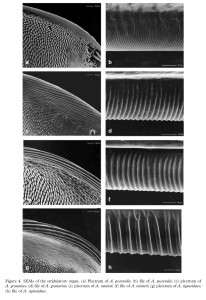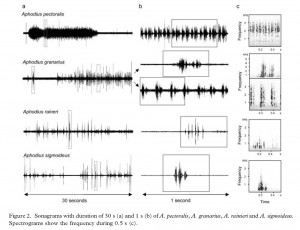Evolutionary biologists from around the world have converged on Ottawa this weekend to partake in the First Joint Congress on Evolutionary Biology. Luckily for those of us who couldn’t make it, there are a ton of people tweeting about talks, the conference and evolution in general. I’ve been watching the #evol2012 hashtag all morning while writing this, and although I’m even more jealous of those that are attending the conference in person, I’m glad I can enjoy a slice of the conference through the tweets of others!
General Entomology
There was plenty of talk about national insects this week. I brought up Canada’s distinct lack of a national insect over at ESC Blog, while Brian Cutting noted how lame many of the state insects are in the US. Meanwhile, across the pond, Africa Gomez found some insects who had come out to celebrate the UK’s National Insect Week.
Charley Eiseman has a fun party trick: watch a walking stick emerge from it’s egg and then get guests to try and figure out how the hell it fit in there to begin with!
While teaching this winter, my students were equal parts horrified and fascinated when we talked about entomopathogenic nematodes. I can’t wait for them to read Ed Yong’s story about the glowing green bacteria who lend a deadly hand.
Dragonfly Woman continues to find cool stuff at her new job, including a magnificent phantom midge larva!
Unlike Gatorade, which fails to contain any actual alligator, Chapul energy bars will contain plenty of ground up crickets to help keep you jumping!
The Amazing Spider-man was released this week and looks great, but I kind of wish Peter Parker had been bitten by any of these other superpower-inducing arthropods.
Diptera
An amazing new fly was described this week by Brian Brown, and now ranks as the smaller species of fly we know of at only 0.4mm long! Brian has an excellent write up of his discovery over at flyobsession, and he also posted a bonus illustration of the fly which wasn’t in the paper.
The Geek in Question was asked what a strange looking aquatic arthropod was.
Dave Stone got up close and personal with a Diogmites robber fly.
In what was easily the most galling post of the week, Charley Eiseman explores the hickory homes of flies.
The Home Bug Gardener starts with a pretty picture of a flower fly, but soon begins an etymological exploration into the meaning behind Syritta pipiens.
Everytime Africa Gomez posts a photo of beautiful fly like this Scaeva pyrastri, it makes me more determined to get to the UK and see some of these things for myself!
And just to further established which order is truly the best:
Seeing gibbons, hornbills, and tons of ants is cool. But the most exciting part of my trip to Cambodia was seeing stalk-eyed flies live.
— Fred Larabee (@bugbiter) July 1, 2012
Boo yah!
Hymenoptera
Fresh off the pixels, Siricidae of the Western Hemisphere was just published in Issue 21 of the Canadian Journal of Arthropod Identification. Including a number of new nomenclatural changes, new species descriptions and beautifully illustrated keys to all of the horntail wasps found in the New World, I highly recommend you check this one out as a sterling example of where taxonomic monographs are heading in the digital age.
If an ant could sneeze, I imagine it would look a little like this.
Arachnophobic statistics professor Dan Gillis discovers he’s sharing his home with mud daubers (Sphecidae) and finds himself in conflict about whether to remove his new neighbours.
Adrian Thysse has a great photo of an aphid-killer that doesn’t get much recognition.
Pretending to be a part of the pack, Takashi Komatsu exposes other interesting imposters amoung army ant raids.
Proof that even honey bees suffer from petty sibling rivaly.
Coleoptera
I’m excited to see so much entomological love at Scientific American Blogs now that Becky Crew has joined the team. Her piece on colour changing tortoise beetles is an absolute must read!
It’s that time of year again when fireflies start making yards and urban parks a veritable orgy of light displays!
A wonderful short story by Derek Niemann about a beetle attempting to climb a blade of grass.
Ted MacRae is running an ID Challenge this week with a twist!
Other Arthropod Orders
Bug Girl is in top form as she asks whether stick insects can really mate for 1400 hours.
Will the Sea Grape Flatid become a pest in the US one day? Ted MacRae worries it might, and he has some nice photos to help people keep an eye out for it.
What do dog-day cicadas and the Teenage Mutant Ninja Turtles have in common? Ask Brian Cutting.
Atlantic Canada had 3 endemic butterflies to call their own, until a keen butterfly collector in Maine went and found one of them just within state lines. Nice post by U of Guelph Diptera alum John Klymko in his new role as director of the Maritime Butterfly Atlas.
Chris Buddle is off to the Yukon in search of a neat Beringian pseudoscorpion.
Taxonomy/Academia
Kai Burington shares his thoughts on the “Do species names need to change?” thread from last week.
On Thursday, University of Wisconsin PhD candidate (and science communication proponent) Jacquelyn Gill defended her thesis and streamed the entire process live over the internet! She did a great job, and I really enjoyed seeing how her live-stream worked, as it’s something that I am hoping to do at the conclusion of my PhD1.
Rosie Redfield (of #ArsenicLife renown) shares some very helpful tips for coming out of your shell and connecting with other people at scientific conferences. I’m pretty bad at this sort of thing, but I’m looking forward to trying some of her tips out this fall!
Science Communication
Christie Wilcox has launched a new wiki to help scientists interested in using social media for science communication find the tool that works best for them.
Although not a scientist, Moose Peterson is a highly published wildlife & conservation photographer who regularly blogs about his work. This letter from one of his reader’s is a perfect example of the power that a blog can have in affecting people’s lives.
If you’re a grad student, you’re probably well aware of PhD Comics and their eerily accurate portrayal of grad student life. A new contest from PhD comics wants to turn YOUR THESIS into an animated comic!
Other Fun Stuff
How useful are those middle-school career aptitude tests? Marine biologist David Shiffman found his old report and puts it’s utility and advice to the test.
Apparently biodiversity ads don’t make enough to warrant inclusion by Google Ads as Chris Clarke found out.
Cuttlefish are much too clever for their own good.
This portrait of a spring peeper (Pseudacris crucifer) by TGIQ is absolutely stunning.
Your thesis can be a comic, but why not submit your own identity to Jason Hogle for the chance to become a character in his upcoming novel series!
In one of the most creative and touching pieces of feature journalism I’ve ever read, the Toronto Star turns up at a woman’s funeral and writes a beautiful biography of her life by interviewing her friends & family.
I leave you today with an interview that John Klymko gave to The Weather Network about record butterfly numbers in the Canadian Maritimes.
Further Reading
Ed Yong – Missing Links – July 7, 2012
Bora Zivkovic – Scienceblogging Weekly – July 6, 2012
—————————
1- Not sure whether I’ve explicitly mentioned this here on the blog, but I’m starting my PhD at the University of Guelph in September! Lots of work to finish up before then, but I’m really excited to become a student again. 




